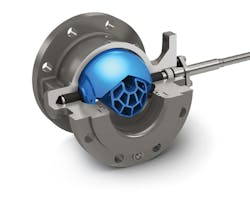Many end users ask for a review of their technical specifications to identify areas adding unnecessary cost and lead time to their valve, actuator, positioner and related accessory purchases.
They need help evaluating if their requirements were truly needed or were actually more than required for their specific applications. A review of specifications typically reveals instances where cost-saving products and options are overlooked, along with inclusion of unnecessary items and procedures.
In many cases, these mistakes drive up cost and lead time because users specify “gold-plated” control valves in applications where less expensive options would work just as well. These over-specified valves not only cost more up front, but can also be harder to maintain and require more spare parts. The preferred alternative is to specify just the valve needed (see Image 1), saving time and money.
This article describes issues often seen when reviewing end user technical specifications and shows how process engineers can specify just what they need – and no more – when ordering valves, actuators, positioners and related accessories.
Reducing costs to green light projects
The biggest challenge facing most capital projects is cost justification. All too often, a valve upgrade or new valve project is based on what has been done traditionally. Unfortunately, this often includes the use of outdated technology, unnecessary options and overly stringent specifications and standards, which can add layers of avoidable costs.
Process engineers are increasingly recognizing the need to incorporate a design without these layers. Instead, they want a fit-for-purpose approach using industry standards and common designs versus customization that adds cost and development time.
Starting at this zero-base by using only what is necessary for the project to be safe, legal and reliable, valve vendors can help evaluate the application and make value-driven choices.
Optimizing specifications
When specifying valves, the end user, control valve vendor and perhaps a systems integrator or engineering, procurement and construction (EPC) firm should evaluate the company’s valve requirements early in the process. All parties involved should discuss how each party can help optimize the specifications and eliminate excessive requirements. These areas include optimizing the control valve, welding and nondestructive evaluation (NDE) specifications.
Some of the requirements leading to unnecessary added costs and excessive lead times include:
- All assembly must occur in North America
- No castings from India or China
- Third-party witness of all welding
The first and second points are outdated remnants of a world gone by. Most valve manufacturers have global facilities with quality equal to American- made products.
For example, an Emerson customer was able to waive the assembly requirement, saving the project $1.2 million and reducing lead time by 20 weeks.
The “no castings” requirement is a repeat offender in specifications and one that regularly meets resistance to removal. Many valve manufacturers have global quality standards enforced on all the foundries they use. Understanding what these standards are and ensuring they are acceptable to an EPC or end user can save 25 percent on project cost and reduce lead times by up to 12 weeks.
The “third-party witness of all welding” requirement can also be dismissed in almost every case. A valve supplier can provide weld procedures for approval by the user and EPC and skip having someone actually come and witness the welding. The welding will still be in compliance with all applicable regulations and standards. This saved a customer $200,000 and reduced the lead time of the project by 12 weeks.
Unnecessary specifications
While reviewing multiple technical specifications from customers just this past year, areas were often discovered where products and technology would be excluded for reasons that may have been true years ago, but no longer apply. Using the word “shall” in a spec dictates no deviation from what is written, often forcing vendors to provide more expensive solutions.
Some unnecessary specifications include:
- Provide throttling ball valve for pulp mill applications.
- Provide globe valves for hot gas recycle applications.
- Cage-guided valves should not be used with high-viscosity fluids, fluids that contain solids or in slurries.
- Rotary valves shall have splined shafts to limit lost motion.
- Stellite is not acceptable in boiler feedwater due to attack of water-treating chemicals.
Such requirements often deny a plant the chance to use new or different proven technologies. For example, a high-performance butterfly valve works just as well as a ball valve in most pulp mill applications. Angle valves can handle hot gas recycle applications just as well as globe valves in many instances, saving weight and often cost and lead time.
Often multiple solutions for the same application, such as outgassing, exist. In these instances, service conditions, sizing methods particular to the application (such as bracket sizing), and end user experience should help determine what valve is the best fit for a particular application. In outgassing applications, there are some cases where a more cost-effective rotary solution can be used, and others where a highly engineered severe-service solution must be used to withstand harsh operating conditions.
The requirement that cage-guided valves should not be used with high-viscosity fluids, fluids that contain solids or in slurries does not allow a plant to use new trim designs even when they would be perfectly acceptable and even a lower cost option in many cases.
The requirement that control valves with special trim for noise reduction should have globe bodies and cage trims eliminates the use of angle bodies or an even more cost-effective solution – a rotary valve with a noise attenuator. Depending on the application, an angle valve might be a better option than a globe valve, or a rotary valve with an attenuator could reduce noise levels and save money (see Figure 1).
The requirement that rotary valves shall have splined shafts to limit lost motion excludes large sizes of rotary valves and scotch yoke pneumatic actuators, often to the detriment of project costs and lead times.
As for the stellite requirement, in 2005 Emerson concluded an investigation revealing that feedwater treatment technologies and methods have changed significantly over the past 25 years, allowing Alloy 6 stellite to be an acceptable solution. And in many cases, 440C stainless steel is more cost-efficient and provides similar erosion resistance.
Exclusion of options
Gold-plated specs tend to eliminate less expensive options, often requiring more expensive solutions with no corresponding operational improvements. Some of these include:
- Threaded seat rings are not acceptable.
- Bonnet bolts shall not be used to attach actuators or mounting brackets.
- Reverse-acting spring diaphragm actuators that incorporate seals or glands should be avoided.
- Valve yokes may be cast iron for fluid operating temperatures up to 800ºF, but shall be cast steel for temperatures exceeding 800ºF.
The threaded seat ring exclusion and the no-bonnet-bolts spec drive a user to more expensive valves by eliminating cost-saving alternatives. Stating that reverse-acting spring diaphragm actuators incorporating seals or glands should be avoided is incorrect. If a valve must fail open, it needs a reverse-acting actuator.
Specifying that valve yokes may be cast iron or cast steel for various temperatures is an incomplete spec because it does not state if extension bonnets can help with high-temperature applications, which is often a more cost-effective solution.
It is difficult to capture all the options offered by valve manufacturers, and it is hard to know if something put into a specification will eliminate an option that could bring the overall project cost down. This is why early review and optimization of specifications and requirements is critical. If valve vendor technical personnel can review specs before the project is bid, they can walk users through the specs and identify problematic areas.
Optimization of work processes
The project team should evaluate its documentation requirements and their impact on the overall schedule. In many cases, end users continue to rely on outmoded and outdated paperwork requirements and procedures. The goal should be to optimize the provision and use of:
- Data sheets and sizing calculations
- Drawings and procedures
- Data packs
- Electronic data exchange, FF2.0 to SPI
- Submittal and approval process
Optimizing these documentation requirements can result in substantial savings. For example, with outdated work procedures, the project team must manually enter data and create/modify 3D control valve shapes for the piping design. In a typical project, this can require:
- Editing 500 data sheets x 1 hour average per tag = 500 engineering hours
- Entering 500 data sheets into a computer system x 0.5 hour each = 250 work hours
- Building 500 valves in 3D models at 0.5 hour each = 250 design hours
- Checking, revisions and management of change = 250 work hours
- Total: 1,250 work hours
Many valve manufacturers now offer computer-based work procedures requiring considerably less time. For example, some procedures allow end users and EPCs to receive data electronically from the vendor to build pre-populated spec sheets, 3D shapes and dimensions – with only a few fields requiring editing – resulting in:
- Editing 500 data sheets x 0.2 hour average per tag = 100 engineering hours
- Importing 500 data sheets into valve sizing software x 0.002 hour each = 1 work hour
- Placing 500 DDP shapes in 3D model at 3 minutes each = 25 design hours
- No checking necessary. Revisions and management of change = 20 work hours
- Total: 145 work hours
Using manual data editing adds 2.5 man-hours per valve, while using automated procedures takes only about 0.3 man-hours per each valve. Automated work processes also reduce rework during construction and minimize schedule delays.
Summary
Working with outdated and unnecessary valve, actuator, positioner and accessory specifications results in increased project costs and lead time by denying access to the latest technology and less expensive solutions. Reviewing valve specifications to identify unnecessary specifications is a necessary first step to cut costs and lead times, and this must be done early in the project.
Janelle Prusha works for Emerson Automation Solutions as a product marketing manager for Fisher Engineered Products in Marshalltown, Iowa. Prusha graduated from Missouri University of Science and Technology in 2012 with a degree in Environmental Engineering and from the University of Iowa in 2016 with an MBA.




